The Future Is Now for Water Reuse
By reusing wastewater, food and beverage companies can cut operating costs, reduce reliance on freshwater resources, and contribute to a sustainable environment.
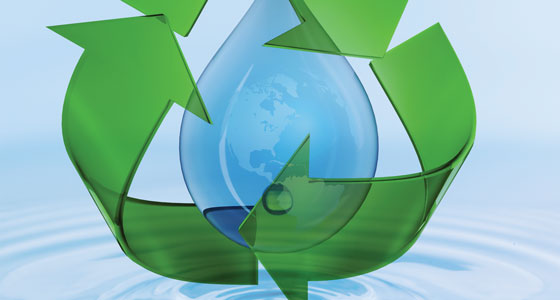
In processing 200 tons of raisins each day, the National Raisin Co., in Fowler, Calif., generates between 60,000 and 80,000 gallons of wastewater, mostly as it washes away dust, sugar, and other contaminants from the raisins. Having invested in a customized treatment system, the company is able to reuse this large volume of water, streamlining operations and saving hundreds of thousands of dollars a year. Throughout the food and beverage industry, businesses like National Raisin are examining ways to become efficient and sustainable. Water—an essential element in food and beverage operations—is a logical place to start.
With increasing regulatory standards and a global concern for the diminishing supply of this precious natural resource, discharging process water into the environment and relying exclusively on municipal systems to deliver freshwater are becoming less acceptable. Accordingly, reclaiming existing wastewater from a facility’s processes with conventional or advanced reuse treatment is a growing practice around the world that offers many financial and environmental benefits. In 2013 the International Life Sciences Institute Research Foundation in Washington, D.C., released the report “Water Recovery and Reuse: Guidelines for Safe Application of Water Conservation Methods in Beverage Production and Food Processing.” One of the goals of the report was to give credibility to the industry’s water reclamation efforts to show that recycled water can be a suitable source for many nonpotable applications from irrigation to plant maintenance.
Global Stewardship
As the earth’s population continues to increase, so does the scarcity of water. Chronic drought conditions in areas such as the western United States also contribute to the scarcity of the water. By one estimate, global freshwater demand will exceed supply by a staggering 40% in 2030 if these factors persist. Having been taken for granted for decades, water is now a critical focal point for governments, communities, and companies.
To that end, government agencies such as the U.S. Food and Drug Administration and the U.S. Environmental Protection Agency (EPA) are creating more health and safety mandates to regulate wastewater. For example, the National Pollutant Discharge Elimination System (NPDES), a division of the EPA, regulates companies discharging water into a river, lake, creek, or other body of water. Companies must follow strict permit requirements, many of which are more stringent than those imposed for water reuse operations. Violations of discharge requirements can lead to punitive fines and facility inspections, and in some cases, the company can be held accountable for environmental damage remediation.
Some businesses discharge wastewater into a publically owned treatment works facility (POTW), which is typically owned by local governments or municipalities. POTWs are sensitive to industrial discharge because of the potential impact it can have on their operations: They are designed to treat domestic sewage, not industrial wastewater. Therefore, businesses are required to pretreat wastewater that goes into the system by removing solids, reducing biochemical oxygen demand, and adjusting pH. In addition, many POTWs require corporations to request permits for discharge, for which fees can be significant. Fines and other penalties can be imposed for violations of discharge permits. Companies that are discharging wastewater either through a POTW or the NPDES should consider the full cost of wastewater disposal when evaluating treatment and reuse of wastewater. In addition, any company that operates in a foreign country should also be aware of international regulatory bodies and standards.
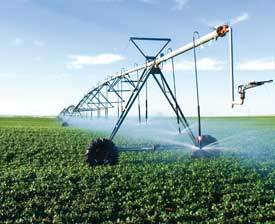 Evaluating Reuse Goals
Evaluating Reuse Goals
Because of these and other issues, there is also greater emphasis on social responsibility and water stewardship. As corporate citizens, businesses must look at their impact on the environment and assess how their operations affect the communities they operate in and serve. By enhancing sustainability practices, businesses ensure that they are maintaining appropriate water quality standards for food and beverage processes. Water reuse can reduce or eliminate dependency on external water sources, thereby lowering the risk of supply disruption and escalating costs. The field of reuse has expanded considerably during the last decade with advances in technology and broader applications, making it more cost-effective for businesses.
Water reuse standards are developed by state and local agencies; there are no federal regulations for reuse. However, the EPA has guidelines that were updated as recently as 2012. In some regions of the country, any new development—commercial, residential, or institutional—is required to connect to a reclaimed water system or install infrastructure to connect when such a system becomes available. Food and beverage operations that are already environmentally minded will have an advantage doing business in these regions.
But before businesses can determine how to optimize their water footprint, they must define their objectives in water reuse from the perspective of cost as well as sustainability. Then they can identify the right treatment option for their operations and the appropriate treatment levels for their specific needs. Whether a facility already has a treatment and reuse system in place or is seeking to build one from scratch, it is important to consult with a water technology expert. Although the contracted company will be able to assist with selecting the right technology and fit, the process can be simplified by understanding the steps required to implement the best solution.
A water technology company often begins the selection process by sending a representative to the plant to meet with decision-makers to review a series of necessary items, including goals, effluent requirements, and concerns essential to properly sizing a system. If a system is already in place, the water technology consultant can determine how to leverage this treatment process with new solutions to find the optimal result to meet the business’s objectives. It may be possible to augment or renovate a system to meet higher standards or improve output quality. However, older systems may use more energy than those that employ more advanced technology; in fact, due to the costs of maintaining an older operation, it is sometimes more budget-friendly to install a completely new system. A new system could introduce long-term cost savings and increase sustainability efforts. If necessary, the consultant will validate technologies and/or treatment processes through testing, which serves as beta-testing for a larger, full-sized system. It is now possible to leverage the treatability testing results and knowledge found in the pilot to scale up for the full design.
--- PAGE BREAK ---
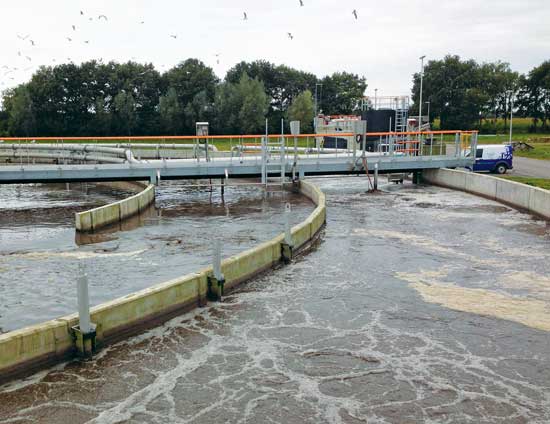 Treatment Options
Treatment Options
One of the biggest challenges facing plant managers in the food and beverage industry is how best to treat their water. Significant amounts of water are needed for use in cooling towers and boilers, the washing of equipment and products, and transport. All of these processes produce large amounts of wastewater, much of which can be reused onsite with appropriate treatment. There is a wide variety of technologies commercially available for wastewater treatment in reuse applications. These technologies can be classified as conventional treatment processes, which can remove solids and adjust pH and chlorine levels, or advanced processes, which filter and oxidize water and result in a higher quality product. Advanced methods provide more flexibility with regard to the use of recycled water.
A conventional treatment process removes solid waste from water. The technologies in this category provide minimal disinfection and include the use of screens, dissolved air flotation and primary clarifiers, filters, biological treatment via conventionally activated sludge, chlorination and pH adjustment, reducing solids, and biochemical oxygen demand. For some reuse applications, such as turf irrigation, conventional treatment may be all that is needed.
When a conventional treatment process isn’t adequate for meeting the required treatment standards, advanced treatment technologies can be implemented. These technologies go further to remove contaminants that conventional treatment processes cannot. They are arranged for specific needs, which can include the following:
• removal of solids and bacteria via microfiltration or ultrafiltration membranes,
• biological nutrient removal with sequencing batch reactors or membrane bioreactors,
• removal of dissolved organics or salts with reverse osmosis,
• removal of trace contaminants and pathogens via oxidation and disinfection, and
• removal of dissolved organics and contaminants via an adsorption process or ozone-enhanced biological active filtration.
Advanced treatment processes can divided into two categories: biological and disinfection. Under biological treatment there are two subcategories: sequencing batch reactor (SBR) and membrane bio reactor (MBR). Generally, SBR will have lower capital requirements than MBR, but MBR systems will cost less to operate. MBR systems combine biological treatment with membrane filtration to provide a high-quality effluent, meet stringent nutrient limits for phosphorus and nitrogen, and have a smaller footprint compared to SBR technology.
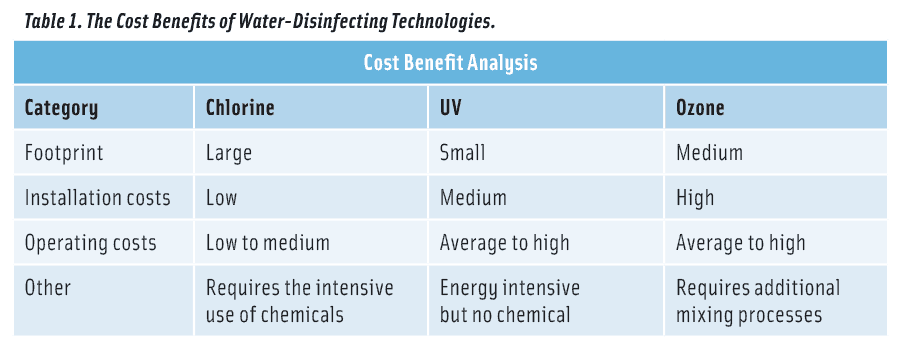 There are three categories of disinfection treatment: chlorine, ultraviolet (UV), and oxidation. The most basic form is chlorine disinfection. In this treatment type, water is filtered with hypochlorite to generate chlorine residual that inactivates pathogens such as bacteria. UV technologies are chemical-free and require less contact time than chlorine disinfection. In UV systems, water is channeled through a reactor that emits UV light at low wavelengths to destroy the DNA structures of microorganisms, including bacteria, viruses, yeasts, and molds. Virtually any liquid can be used with this technology, so it is often found in beverage processing plants; however, UV is sensitive to the clarity of the water. Higher clarity water requires less energy to treat, and as a result, pretreatment of wastewater is common in UV disinfection systems. And ozone and advanced oxidation processes (AOP) are powerful oxidation treatment technologies that generate hydroxyl radicals, the strongest oxidant used in water treatment. AOP is an ideal disinfection approach to treat recalcitrant contaminants that are otherwise not removed by other technologies. AOP and ozone technologies are commonly coupled with other filtration technologies.
There are three categories of disinfection treatment: chlorine, ultraviolet (UV), and oxidation. The most basic form is chlorine disinfection. In this treatment type, water is filtered with hypochlorite to generate chlorine residual that inactivates pathogens such as bacteria. UV technologies are chemical-free and require less contact time than chlorine disinfection. In UV systems, water is channeled through a reactor that emits UV light at low wavelengths to destroy the DNA structures of microorganisms, including bacteria, viruses, yeasts, and molds. Virtually any liquid can be used with this technology, so it is often found in beverage processing plants; however, UV is sensitive to the clarity of the water. Higher clarity water requires less energy to treat, and as a result, pretreatment of wastewater is common in UV disinfection systems. And ozone and advanced oxidation processes (AOP) are powerful oxidation treatment technologies that generate hydroxyl radicals, the strongest oxidant used in water treatment. AOP is an ideal disinfection approach to treat recalcitrant contaminants that are otherwise not removed by other technologies. AOP and ozone technologies are commonly coupled with other filtration technologies.
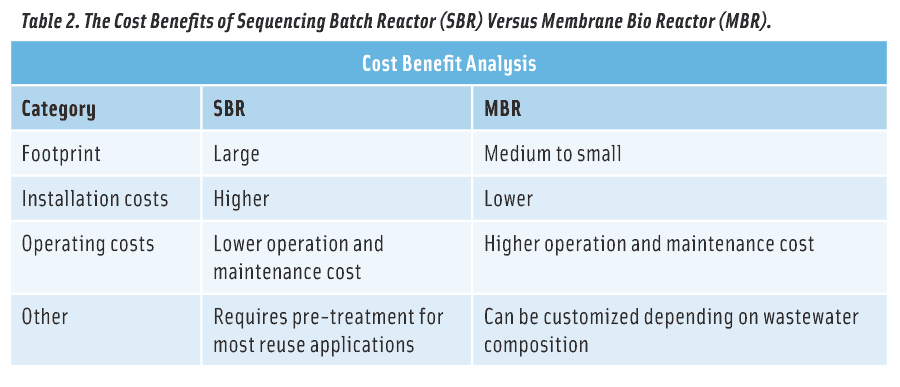 In addition to the aforementioned biological and disinfection techniques, there are other advanced treatment technologies that can be used either separately or collectively to fulfill wastewater discharge requirements. Membrane filtration, using technologies such as microfiltration and ultrafiltration, removes suspended solids found in the processing of foods and beverages. These technologies can remove some viruses, bacteria, and other pathogens. For example, reverse osmosis involves the use of a semipermeable membrane to remove salts and many dissolved organics. Reverse osmosis is used when the highest quality reuse water is needed, such as high-pressure boiler feed water, or when low salt and contaminant levels are required. Reverse osmosis can be expensive and generates a concentrated brine waste stream that must be managed via proper disposal. A leading global beverage company uses reverse osmosis and UV disinfection to purify beverage process wastewater for use in non-product applications. By doing so, the company reduced its water use up to 35% in two of its facilities.
In addition to the aforementioned biological and disinfection techniques, there are other advanced treatment technologies that can be used either separately or collectively to fulfill wastewater discharge requirements. Membrane filtration, using technologies such as microfiltration and ultrafiltration, removes suspended solids found in the processing of foods and beverages. These technologies can remove some viruses, bacteria, and other pathogens. For example, reverse osmosis involves the use of a semipermeable membrane to remove salts and many dissolved organics. Reverse osmosis is used when the highest quality reuse water is needed, such as high-pressure boiler feed water, or when low salt and contaminant levels are required. Reverse osmosis can be expensive and generates a concentrated brine waste stream that must be managed via proper disposal. A leading global beverage company uses reverse osmosis and UV disinfection to purify beverage process wastewater for use in non-product applications. By doing so, the company reduced its water use up to 35% in two of its facilities.
--- PAGE BREAK ---
Pumping Systems
Treating water is only the first step to ensuring wastewater is recycled and reused efficiently and effectively within a plant. It is important for organizations also to consider the transportation and storage of recyclable water. Treatment and pumping systems are primary forms of energy consumption within a water or wastewater loop. Sizing the system and selecting the right equipment to meet specific reuse requirements are critical to maximize energy savings over the life of the equipment.
Pumps serve two purposes in a water reuse system: transporting and boosting pressure. Water needs to be moved from one location to another for treatment, storage, or usage. Pressure boosting is required for some treatment technologies, including reverse osmosis, in which pressure is used to move water through a membrane. Many reuse applications, such as irrigation and equipment washing, also require boosting.
The type of pump and piping can have considerable impact on the energy consumed during the life of a water reuse system. Xylem, Rye Brook, N.Y. (www.xyleminc.com), a global leader in water technology, estimates that a water reuse system with improperly sized pumps and piping increases energy consumption by up to 300%. Food and beverage plants can substantially improve energy efficiency in water reuse by adhering to the following steps:
1) Determine the flow rate, which is the volume of fluid that passes through the pump per unit of time.
2) For a transport application, determine the static head and friction loss for the piping system.
• Static head: the height of a column of water that would be produced at a given pressure. The calculation represents the internal energy of a fluid due to the pressure exerted on it from the pump.
• Friction loss: the loss of energy (reduction of static head) that occurs in the pipe due to viscous effects generated by its size and surface. Narrow pipes, corners, and valves that impede flow create friction loss; this should be minimized.
3) For a boosting application, determine the pressure needed and friction loss for the piping system.
4) Determine the water makeup and comparability.
• Check the density of the water.
• Check chemical compatibility, such as pH levels.
5) Select the pump.
• Find the flow curves and best efficiency point, which is the operating point at which the pump runs at maximum hydraulic efficiency.
• Choose a net positive suction head, which is the suction head value at a specific flow point that is required to keep the pump out of cavitation.
• When making the final decision, consider the following:
• certifications (e.g., Underwriters Laboratories (UL), CE Marking, NSF-61 for potable water)
• environmental conditions (to determine the correct motor enclosure)
• voltage requirements
• variable speed options and controllers
Additional Factors
To fully understand the benefits of implementing a new treatment process or adding to an existing one, there are many factors to consider, including the costs of the facility’s current processes and costs for power, water, discharge, and compliance. By taking a holistic approach to water-related issues, businesses will operate more efficiently and help protect and preserve the environment.
A global snack food company began recycling up to 75% of its process water and has become one of the first food manufacturing plants in the country to be LEED-certified. The company’s wastewater goes through a process-water-recovery treatment plant, which has helped reduce its water use by 100 million gallons a year. The treated water is used in non-process applications, meets EPA primary and secondary drinking water standards, and is of a higher quality than local potable water.
EPA case studies on water reclamation and reuse in beverage processing facilities around the world from Canada to Thailand report success in reducing wastewater discharge and maximizing efficiencies with customized treatment options. These success stories indicate that properly treated water for reuse is a safe and efficient way to do business.
Nathan Maguire is business unit director, industry & agriculture,
Americas, Xylem Inc., Irvine, Calif. ([email protected]).
Greg Claffey is director of treatment sales,
North America, Xylem Inc., Charlotte, N.C. ([email protected]).
